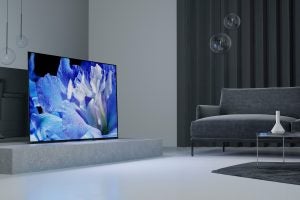Sony AF8 OLED Review
Sony AF8 OLED
Not the brightest OLED TV, but still lovely
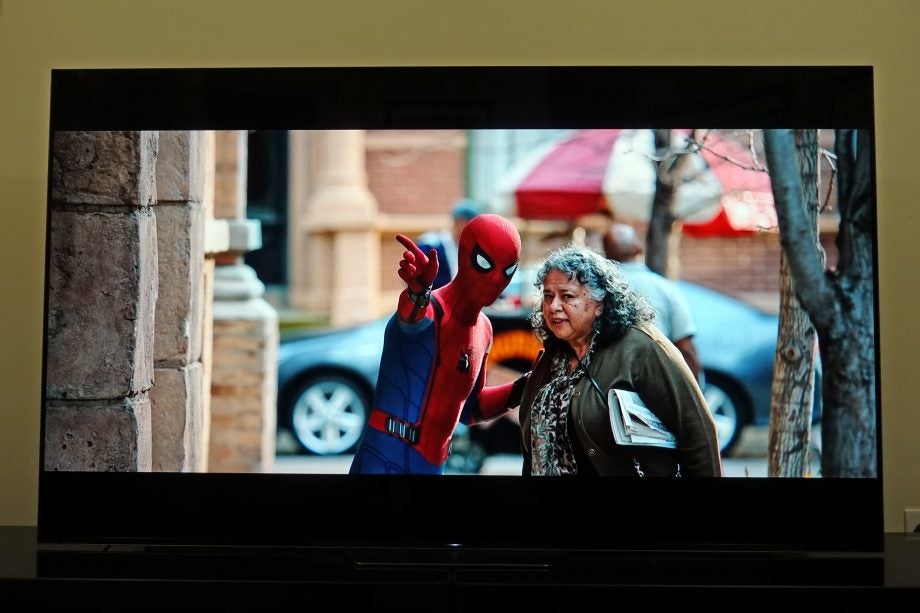
Verdict
Pros
- Excellent detail and colour refinement
- Lovely design
- Acoustic Surface
Cons
- Android TV is still messy
- Poor remote
- Not the brightest by 2018 standards
Key Specifications
- Review Price: £3299
- Ultra HD 4K resolution
- HDR10, HLG and Dolby Vision support
- 4x HDMI
What is the Sony AF8/A8F?
Sony’s TV strategy this year is rather curious. After coming out with the most striking and exciting OLED TV of 2017, the Japanese giant’s 2018 follow-up is a relatively low-key affair. That’s because the new Sony AF8 OLED (A8F in the US) isn’t a true ‘second-generation’ follow-up to last year’s wildly successful Sony A1.
It’s a facelift, the opposite of the thing Apple does where they update an existing phone’s performance but leave the body identical. The performance is largely unchanged, but the body has had a tweak.
The result is an excellent OLED TV by 2017 standards, which can’t really compete with the 2018 big dogs such as the Samsung Q9FN or the LG C8 OLED. The AF8 hits the market with less impact than the Sony A1 did, although that’s no bad thing, since its launch price is way lower.
Reviewed here is the 65-inch Sony KD-65AF8, which is yours for £3299. The 55-inch Sony KD-55AF8 can be found at £2499. That’s the same current price range as 2017’s Sony A1 OLED after a year of price cuts, although the LG C7 and Panasonic EZ952 are cheaper still.
Note: The Sony AF8 is the TV’s name in the UK. In the US, it is called the Sony A8F.
Related: Best TVs
Sony AF8 OLED – Design
It stands straight. That’s literally the big news and reason you might consider the Sony AF8 OLED over the A1. Last year Sony went with an A-frame design, with the screen leaning back by about five degrees. I loved it, but some people weren’t keen. Sony listened to feedback and so this is the vertical alternative.
Alright, so there is still a tiny lean, but it’s no more than two degrees and it seems to be more of a safety feature than anything. It’s barely perceptible even when you’re standing side-on, so it will look vertical from the sofa.
Not having an A-frame significantly reduces the TV’s footprint. With the A1, you needed a bench at least 339mm deep and as wide as the screen. The Sony AF8 OLED uses a minimalist central pedestal just 255mm deep, so you’d have no problem placing it on a regular-sized AV rack or table.

It’s also good news for wall-mounters. The folded-up A-frame of the A1 meant a gap of 107m. The AF8’s electronics have been spread out across the entire width of the TV, and now protrudes just 76mm from the wall.
Take away the lean and the stand and the AF8’s overall look is entirely in line with the A1. Sony’s ‘One Slate’ design philosophy means there’s very little to look at besides the screen. There’s a tiny logo tucked away in the corner. The only thing ‘bling’ about the TV is the LED in the centre, but even this can be switched off. If you want a picture-only design, this is it.
I’m less fond of the remote control. It’s a plasticky and crowded slab of buttons that was the norm up to a few years ago, but more recently Sony’s rivals have been shipping premium TVs with more inspiring alternatives. LG’s ‘Magic’ remote uses motion sensors to control an on-screen pointer, while Samsung’s streamlined aluminium wand is a thing of beauty.
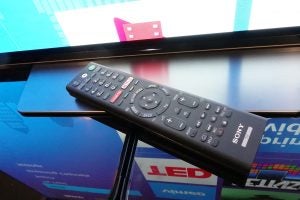
Sony AF8 OLED – Features
A Ultra HD 4K resolution (3840×2160 pixels) is given at this level, as is high dynamic range (HDR). Supported HDR formats include the standard HDR10, and the incoming broadcast-friendly Hybrid Log-Gamma (HLG).
There will also be support for the dynamic metadata-toting Dolby Vision, which can optimise the picture scene by scene, although when this will come later via firmware update.
Internally, this is very much the same TV we got with the Sony A1 OLED. The AF8 uses the same excellent 4K HDR Processor X1 Extreme chip, which excels at detail and colour refinement.
‘Acoustic Surface’ was the most exciting feature was first introduced with the A1, and I’m very happy to see it return. Basically, the screen is mostly responsible for audio. Actuators vibrate the screen, which then functions as a giant speaker.
That’s only possible with OLED’s thin screens – you’ll never find this tech on thicker LCD TVs. You don’t see the vibrations, since the screen only handles higher-to-mid frequencies too fast for human eyes – bass notes are handled by a separate woofers behind the screen.
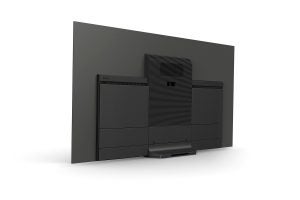
But wouldn’t that mess the screen up? Apparently not. I raised that question last year when the A1 came out, and Sony said they’re confident the screen would be just fine. The lack of complaints over the last year seems to back up that assertion – so I’m not worried about the AF8.
As for connections: there are three USB ports and four HDMI inputs. All four of them are HDMI 2.0 and support HDCP 2.2. Unfortunately, only Input 2 and Input 3 support 4K at 60fps with 4:4:4 colour.
Finally, the software. Sony continues to use Android TV. Things I like about this: easy set-up using Android phones, integrated Google Cast, Google Home compatibility. I can see the appeal of this integrated approach.
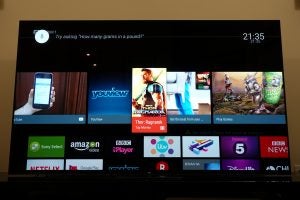
The homepage presentation remains a mess, though. There two sections for app tiles. Sony’s own useful setup tips are mixed in with Google Play’s promoted movies and randomly recommended YouTube videos I have no interest in. I much prefer the intuitive and easily customisable pop-up bar approach favoured by LG and Samsung. Oh, and Android TV is also often slow enough to grate, especially if you just want to pop into the settings in a hurry.
At least app support is good: there are 4K HDR versions of Netflix, Amazon Video and YouTube. YouView support also means you get the key terrestrial catch-up apps: BBC iPlayer, ITV Hub, All 4 and Demand 5.
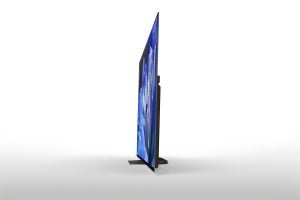
Sony AF8 OLED – Performance
I’d feel a little bad comparing the Sony AF8 against other 2018 flagship models (such as the Samsung Q9FN or LG C8 OLED). It technically uses ‘last-gen’ tech and has an appropriately lower launch price. Then again, it does so many things right and remains an excellent TV, so I’m going to compare them anyway.
Let’s start with brightness, which is the most obvious difference. The Sony AF8 achieves a peak of about 700 nits, which is consistent with last year’s A1. Meanwhile this year’s LG OLEDs, such as the LG C8, offer about 100 nits more. The Samsung Q9FN is the brightest of the lot at 2000 nits.
Brightness really isn’t everything, but if you’re after a proper HDR punch, the Sony AF8 is outmatched, especially if you want to watch TV in bright rooms, or during the day with curtains opened. So, manage expectations accordingly.
That’s really the only complaint I have about the Sony AF8, and even then it’s not a proper complaint because the lower brightness is reflected in the smaller price tag. Elsewhere, I’m happy to report the Sony AF8 performs just like the Sony A1. That was, and still is, a fantastic TV.
Related: Sony TVs 2018: What you need to know before you buy Bravia
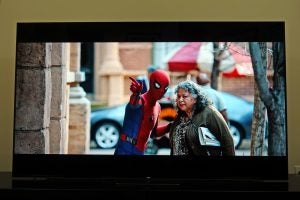
OLED panels may not excel at brightness but this is balanced out by impeccable lighting control down to pixel level. Light and dark elements can be juggled with zero chance of the blooming or halo effects often associated with LCD models. Viewing angles is another advantage – you can sit anywhere in the room without worrying about the losing out on brightness or colour.
By now it’s no news that an OLED TV can reach inky, properly deep blacks – but the Sony AF8 demonstrates a good amount of shadow detail too. Compared to the LG C8, dark scenes on the Sony do demonstrate a little more crushing, but the flip side is that the Sony also demonstrates less picture noise, as well as less clipping in highlights.
Motion handling is strong enough not to worry about the latest generation. With the MotionFlow processing set to Standard or True Cinema mode, the picture is smooth while retaining a natural look. It avoids unwanted artefacts, or that horrible glossy ‘soap opera’ effect that comes with overly aggressive frame interpolation. In fact, I’d say the motion here is better than this 2018’s Samsung Q9FN.
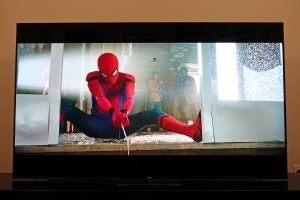
There’s a lovely sense of refinement to both detail. The 4K resolution is nothing new, but textures here are fine and very subtle without looking etched and overly sharpened. The colours exhibit the same level of refinement – tone blends are nicely done with little posterization (or ‘banding’).
As for audio performance, I remain a big fan of the Acoustic Surface tech. It does a good job of effects steering and placement; sound generally feels like it’s coming from specific parts of the screen. The tonal balance is good, too – I never felt the need to switch over to proper speakers or a soundbar, although you’ll still need one for big movie soundtracks as the Sony AF8 won’t be shaking the room. Also, I feel the AF8 has less bass punch than the Sony A1 did last year.
Related: Best soundbars
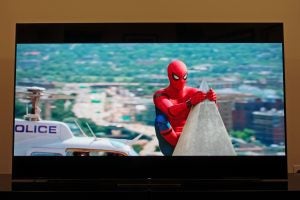
Finally, a word on gaming. Like all good TVs, the Sony AF8 has a dedicated Game mode, which turns off much of the processing to reduce latency. Here we have input lag of between 30ms and 45ms. That’s not amazing, but while it won’t appeal for competitive gamers, I didn’t feel it significantly affected my performance.
I’ll leave you with a few words on set-up. There’s actually very little that needs to be done, as the presets are very good right out of the box. I would say to stick to Standard or Cinema viewing mode. The former is more punchy and bright, but the latter is more accurate with colours. For motion processing, I’d keep MotionFlow on either Standard or True Cinema mode.
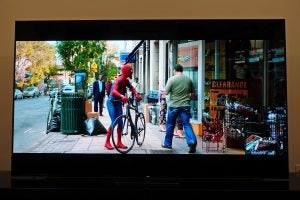
Why buy the Sony AF8 OLED?
If you liked the idea of 2017’s Sony A1 but didn’t like the leaning design, this TV is for you. It’s pretty much the same TV, and while it doesn’t represent the very latest in 4K and HDR tech, it’s an excellent TV.
It doesn’t get as bright as other 2018 flagship TVs such as the Samsung Q9FN or the LG C8 OLED, but it does come with a smaller price tag. The Sony AF8’s motion handling and high levels of refinement are also among the best available.
If you’re short on cash, however, many of the 2017 flagship alternatives can be found for less.
I’d wait a little, however. The Sony AF9 OLED and ZF9 LCD have just been announced, and they explain why Sony held back a little with the AF8. We’ll be reviewing those soon, meanwhile you can read about them here: Sony’s new Master Series 4K TVs could be the ultimate way to watch Netflix.
Related: Best 4K TVs
Verdict
A classic, redesigned. Not the best by the latest standards, but still excellent.
How we test televisions
We test every TV we review thoroughly over an extended period of time. We use industry standard tests to compare features properly. We’ll always tell you what we find. We never, ever, accept money to review a product.

